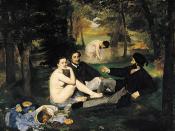Ãdouard Manet Beggar with Oysters (Philosopher) 1865/67
Upon entering the room, Manet's Beggar with Oysters immediately caught my attention. The vagabond has the appearance of being captured in a moment of introspectiveness.
In the painting, a bearded man, wearing a hat, covered with a blanket appears from an empty, dark background. An invisible light brightly illuminates his face. At his feet six oysters lay on a pile of hay.
By setting him against a hollow, dark background, Manet seems to isolate this man from time and space, making his contemplation perpetual. He is a thinker. He may be a philosopher who, by being a social outcast possesses rare wisdom. But maybe, his expression of dreamy thoughtfulness is absent-minded.
On the street, a beggar is looked down on, but this large-scale painting forces you to look up. He has a grand presence and a perplexing look, worthy of questioning. Some, I think, may feel uncomfortable by this puzzling visage and his imposing dimensions; others will join him in thought and reflection.
The man is not aware of the spectator (In contrast with "Beggar with Duffle Coat" in which the beggar implores to the viewer) and I think the oysters on the bottom right corner are a symbol of this. He appears to be closed upon himself, like an oyster.
From close by, one can appreciate Manet's brushstrokes, minimal and general but impressively poetic and powerful. Figures that from afar seem so life-like turn abstract when looked at closely. Manet seems to have reached a level of remarkable coherence.
Maybe this painting is criticizing vague and shallow philosophy, as if the beggar was saying, "The world is my oyster" that he has the freedom to do whatever he wants, but if the world is an oyster and you are free to...


